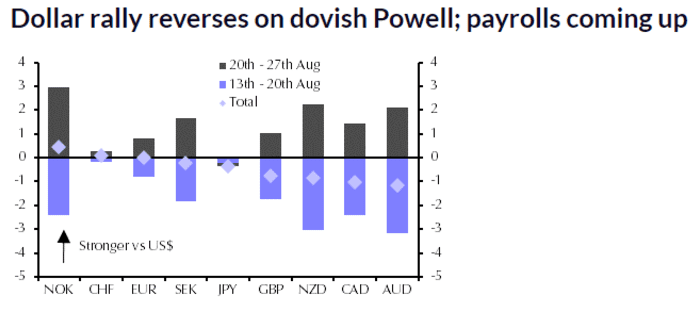This post was originally published on this site
If there was any doubt that Federal Reserve Chairman Jerome Powell’s comments, delivered virtually at the Jackson Hole symposium on Friday, were being interpreted as dovish, the dollar’s reaction should clear up any questions.
The U.S. greenback, as gauged by the ICE U.S. Dollar Index
DXY,
turned decidedly lower, and was down 0.4%, at last check on Friday, and was down 0.9% for the week, FactSet data show. A weekly slide of 0.9% would represent the sharpest decline for the index, which measures the greenback against a half-dozen currencies, since the week ended May 7, when it fell 1.2%.
The buck was trading around its lowest level since Aug. 16, at last check on Friday.
“The U.S. dollar has shed an immediate 20 pips against most of its major rivals, with the U.S. dollar index hitting a 10-day low beneath 92.80 so far,” wrote Matt Weller, global head of research at FOREX.com and City Index, in a note following Powell’s comments.
On Friday, Fed Chairman Jerome Powell said that he advocates a 2021 start to tapering the central bank’s bond purchases implemented during the worst of the financial market disruptions in 2020, but said he doesn’t foresee the central bank raising benchmark interest rates, which currently stand at a range between 0% and 0.25%, soon.
On top of that, he seemed to signal that the Fed was in no hurry to raise interest rates.
Powell’s comments implied to bulls on Wall Street that the low-interest rate regime borne out of the COVID-19 pandemic might continue somewhat longer, which poses a big negative for dollar bulls, at least in the short term.
The Fed boss’s remarks suggest that he may be giving himself more room to digest further data as he moves toward normalizing the central bank’s monetary policy.
“Given Powell’s ongoing emphasis on the labor market, the next few nonfarm payroll employment reports, including next Friday’s, will be particularly significant in determining the timing and pace of the central bank’s tapering plans,” Weller wrote.
Friday’s moves for the buck also come after the index touched put in a weekly rise of 1.1%, its best since the period ended June 18, bringing the currency to around a nine-month peak.
However, not everyone thinks the currency’s downturn will be lasting.
“Nonetheless, we think that this will prove a temporary setback, and that the greenback will appreciate a bit further in final months of the year as the prospects for Fed policy normalization improve and U.S. bond yields rebound by more than those in other major economies,” wrote Jonas Goltermann, senior markets economist at Capital Economics, in a Friday research note.

Capital Economics
Goltermann pointed to a rebound for the benchmark 10-year Treasury note yield
TMUBMUSD10Y,
which fell to around 1.32% on Friday, and a strong labor market, as likely impetuses for an eventual dollar rebound.
The dollar’s decline on Friday came as the Dow Jones Industrial Average
DJIA,
the S&P 500 index
SPX,
and the Nasdaq Composite
COMP,
finished at or near all-time highs.

